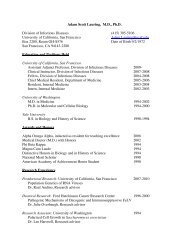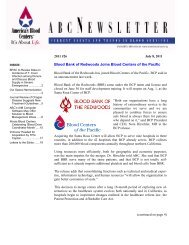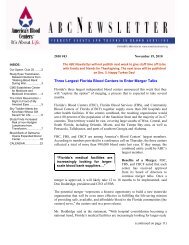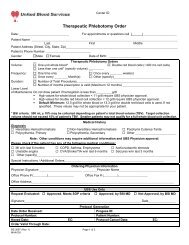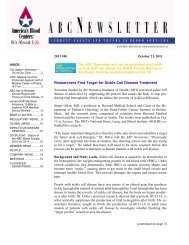Therapeutic Apheresis Informed Consent - United Blood Services for ...
Therapeutic Apheresis Informed Consent - United Blood Services for ...
Therapeutic Apheresis Informed Consent - United Blood Services for ...
You also want an ePaper? Increase the reach of your titles
YUMPU automatically turns print PDFs into web optimized ePapers that Google loves.
Center In<strong>for</strong>mation:<br />
Patient's Name: ID #:<br />
Phone #:<br />
GENERAL INFORMATION:<br />
<strong>Therapeutic</strong> <strong>Apheresis</strong> <strong>In<strong>for</strong>med</strong> <strong>Consent</strong><br />
All apheresis procedures have basic principles in common: <strong>Blood</strong> is withdrawn through a needle or catheter and mixed<br />
with an anticoagulant as it is drawn. The blood is pumped through the cell-separator and the desired components are<br />
collected in a sterile plastic container. Most of the blood in the cell-separator is then returned to the patient. All<br />
equipment used is commercially available, and all materials coming in contact with the patient’s blood are sterile, only<br />
used once and then destroyed.<br />
<strong>Therapeutic</strong> <strong>Apheresis</strong> is the process of withdrawing blood from a patient, removing a specific component and<br />
subsequently reinfusing the remaining components to treat or palliate a disease. <strong>Therapeutic</strong> <strong>Apheresis</strong> consists of the<br />
following procedures:<br />
1. Plasma Exchange – The removal of plasma (the liquid portion of the blood) from a patient and replacement with a<br />
solution mixed into the cellular portion of the blood. The replacement solution may be plasma, 5% albumin, normal<br />
saline or lactated Ringer’s solution.<br />
2. Red Cell Exchange – The removal of a predetermined volume of red blood cells and transfusion of allogeneic red<br />
blood cells with reinfusion of the patient’s other blood components.<br />
3. Cytapheresis – The removal of platelets and/or white blood cells <strong>for</strong> therapeutic reasons.<br />
Depending on the patient’s disease, <strong>Therapeutic</strong> <strong>Apheresis</strong> may be per<strong>for</strong>med as often as daily when prescribed by the<br />
ordering physician.<br />
RISKS OF THERAPEUTIC APHERESIS:<br />
The risks of <strong>Therapeutic</strong> <strong>Apheresis</strong> include, but are not limited to, the following:<br />
1. Weakness, nausea or felling faint as a result of anxiety or decrease in blood volume. Such episodes can be<br />
controlled readily by the immediate return of red blood cells and increase in fluid replacement.<br />
2. Tenderness at needle site. Needles may be placed in one or two veins during the entire apheresis procedure. Both<br />
the presence of the needle and saline infusion may cause some local discom<strong>for</strong>t.<br />
3. Localized infection at needle puncture site. Such a risk is extremely small because aseptic technique is used<br />
throughout the procedure.<br />
4. It may be necessary to transfuse blood components from volunteer blood donors. Complications associated with<br />
transfusions of blood components may include:<br />
A. Fatal hemolytic transfusion reactions caused by administration if incompatible blood.<br />
B. Transmission of infectious diseases or agents such as hepatitis, AIDS, cytomegalovirus, bacteria or those<br />
causing malaria and other rare diseases.<br />
C. Alloimmunization: The production of antibodies against donor red blood cells, white blood cells or platelet<br />
antigens.<br />
D. Allergic reactions, febrile reactions and circulatory overload may also occur.<br />
BS 707A (Rev. 4)<br />
SVC100
5. Loss of red blood cells due to leakage or breakage of the plastic tubing or containers may occur and thus prevent the<br />
return of the red blood cells to the patient.<br />
6. Possible anticoagulant discom<strong>for</strong>t: Sodium citrate, an anticoagulant, is added to the red blood cells and plasma to<br />
prevent blood clotting. Sodium citrate is metabolized by the body. Although it is not toxic, it can sometimes cause<br />
temporary symptoms of tingling of the lips and/or fingers and increased muscle tension during the return of blood.<br />
7. Premature termination of procedure: Since the removal of blood and return of blood is accomplished through the use<br />
of needles and tubing, it is possible that clotting could occur in the needles or tubing and this may lead to the<br />
termination of the individual procedure.<br />
8. Hemolysis: There is a remote possibility of disrupting the red blood cells due to a malfunction of the machine;<br />
however, this is extremely rare and is carefully monitored. In the event of Hemolysis the procedure would be<br />
discontinued.<br />
9. Air Infusion: Although the machine is equipped with an air detector to prevent air bubbles, there is a remote<br />
possibility of an air bubble entering the donor. The consequence of this unlikely event could be severe and result in<br />
death.<br />
INFORMED CONSENT:<br />
I am voluntarily consenting to one of the following procedures checked below:<br />
Plasma Exchange Red Cell Exchange Platelet Depletion White Cell Depletion<br />
Other (Specify)<br />
I hereby authorize <strong>Blood</strong> Systems, Inc.\dba <strong>United</strong> <strong>Blood</strong> <strong>Services</strong> personnel to per<strong>for</strong>m the withdrawal of my blood by<br />
either a continuous or intermittent flow cell-separator; the extraction of the appropriate blood component; the reinfusion of<br />
my own anticoagulated blood and/or plasma, as appropriate; and, if necessary, the reinfusion of replacement fluids and/or<br />
blood components.<br />
I understand that certain tests, including screening tests <strong>for</strong> hepatitis, syphilis, HIV (AIDS) and HTLV, may be per<strong>for</strong>med<br />
on my blood. Depending upon the results of these tests, my name may be placed in a confidential Disqualified Donor<br />
Director of individuals who may not donate blood. I also understand that my physician will be advised of these test<br />
findings and that certain test results may be reported to the state health department in accordance with the policies of<br />
<strong>Blood</strong> Systems, Inc. and applicable law.<br />
Questions regarding my disease and treatment are best answered by my physician.<br />
The procedures and risks have been explained to me. I have been given ample opportunity to ask questions about the<br />
procedures and about the risks, hazards and possible complications involved. All questions have been answered to my<br />
satisfaction.<br />
My consent to the procedure(s) may be withdrawn at any time, either orally or in writing, or may be terminated at any time<br />
upon the advice of my physician(s), and withdrawal from the <strong>Therapeutic</strong> <strong>Apheresis</strong> program will result. In the event of a<br />
reaction or complication, the Medical Staff will provide immediate emergency medical care as indicated.<br />
I hereby authorize that the plasma and/or blood cells removed from me may be either discarded or utilized <strong>for</strong> research or<br />
diagnostic purposes as necessary.<br />
The procedure and potential hazards that may accompany this procedure were explained to me by:<br />
(Physician/Designee)<br />
Patient/Guardian Signature<br />
Witness Signature<br />
(UBS Personnel)<br />
Date<br />
Date<br />
(Print Name)<br />
BS 707A (Rev. 4)<br />
SVC100



